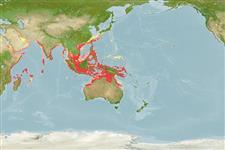Common names from other countries
Environment: milieu / climate zone / depth range / distribution range
Ecologia
marinhas demersal; intervalo de profundidade 1 - 100 m (Ref. 9792), usually 20 - 50 m (Ref. 9792). Tropical; 26°N - 21°S, 43°E - 156°E (Ref. 54739)
Indo-West Pacific: Red Sea and East Africa to Japan and Australia.
Comprimento de primeira maturação / Tamanho / Peso / Idade
Maturity: Lm 38.0, range 37 - 39 cm
Max length : 64.0 cm TL macho/indeterminado; (Ref. 6006); common length : 50.0 cm TL macho/indeterminado; (Ref. 5450); peso máx. publicado: 9.0 kg (Ref. 1468)
Descrição suscinta
Chaves de identificação | Morfologia | Morfometria
Espinhos dorsais (total) : 9 - 11; Raios dorsais (total) : 38 - 45; Espinhos anais: 1; Raios anais : 33 - 43; Vértebras: 23 - 25. Body oval and flat, but thicker than in most other flatfishes. Mouth large with strong teeth; maxillary extends well beyond hind edge of lower eye; both eyes on left or right side; upper eye lying immediately below dorsal edge; gill rakers not developed. Dorsal fin origin well posterior to eyes; anterior fin rays spinous; lateral line almost straight. Color usually brown or grey, sometimes with 4 broad, dark crossbars. Dorsal, anal and caudal fin tips black. Blind side occasionally partially colored. (Other sources of morphological data: Refs. 591, 529, 4416, 5997 and 6000).
Found on sand and mud bottoms (Ref. 9796, 48637). Usually deeply burried in the substrate during the day, but out and hunting at night (Ref. 48637). Often swims in an upright position (Ref. 9796). Mainly piscivorous (Ref. 5986). Mainly sold fresh (Ref. 5213); also utilized smoked and frozen (Ref. 9987). Processed into fish flour (Ref. 6040).
Studies in Porto Novo, India (Refs. 5993 & 5997) show that the sex ratio significantly differ from 1:1, but the reports are ambiguous as to which sex predominates.
Nielsen, J.G., 1984. Psettodidae. In W. Fischer and G. Bianchi (eds.) FAO species identification sheets for fishery purposes. Western Indian Ocean fishing area 51. Vol. 3. (Ref. 3485)
Status na Lista Vermelha da UICN (Ref. 130435)
CITES (Ref. 128078)
Not Evaluated
Ameaça para os humanos
Harmless
Uso pelos humanos
Pescarias: espécies comerciais
Ferramentas
Relatórios especiais
Baixar XML
Fontes da internet
Estimates based on models
Preferred temperature (Ref.
115969): 26.6 - 29.1, mean 28.2 (based on 1198 cells).
Índice de diversidade filogenética (Ref.
82804): PD
50 = 0.7500 [Uniqueness, from 0.5 = low to 2.0 = high].
Bayesian length-weight: a=0.00676 (0.00507 - 0.00901), b=3.14 (3.06 - 3.22), in cm Total Length, based on LWR estimates for this species (Ref.
93245).
Nível Trófico (Ref.
69278): 4.4 ±0.3 se; based on diet studies.
Resiliência (Ref.
120179): médio(a), tempo mínimo de duplicação da população 1,4 - 4,4 anos (K=0.26-0.5; tm=3-4; Fec=300,000).
Prior r = 0.74, 95% CL = 0.49 - 1.11, Based on 3 data-limited stock assessments.
Fishing Vulnerability (Ref.
59153): Low to moderate vulnerability (29 of 100).
Climate Vulnerability (Ref.
125649): High to very high vulnerability (68 of 100).
